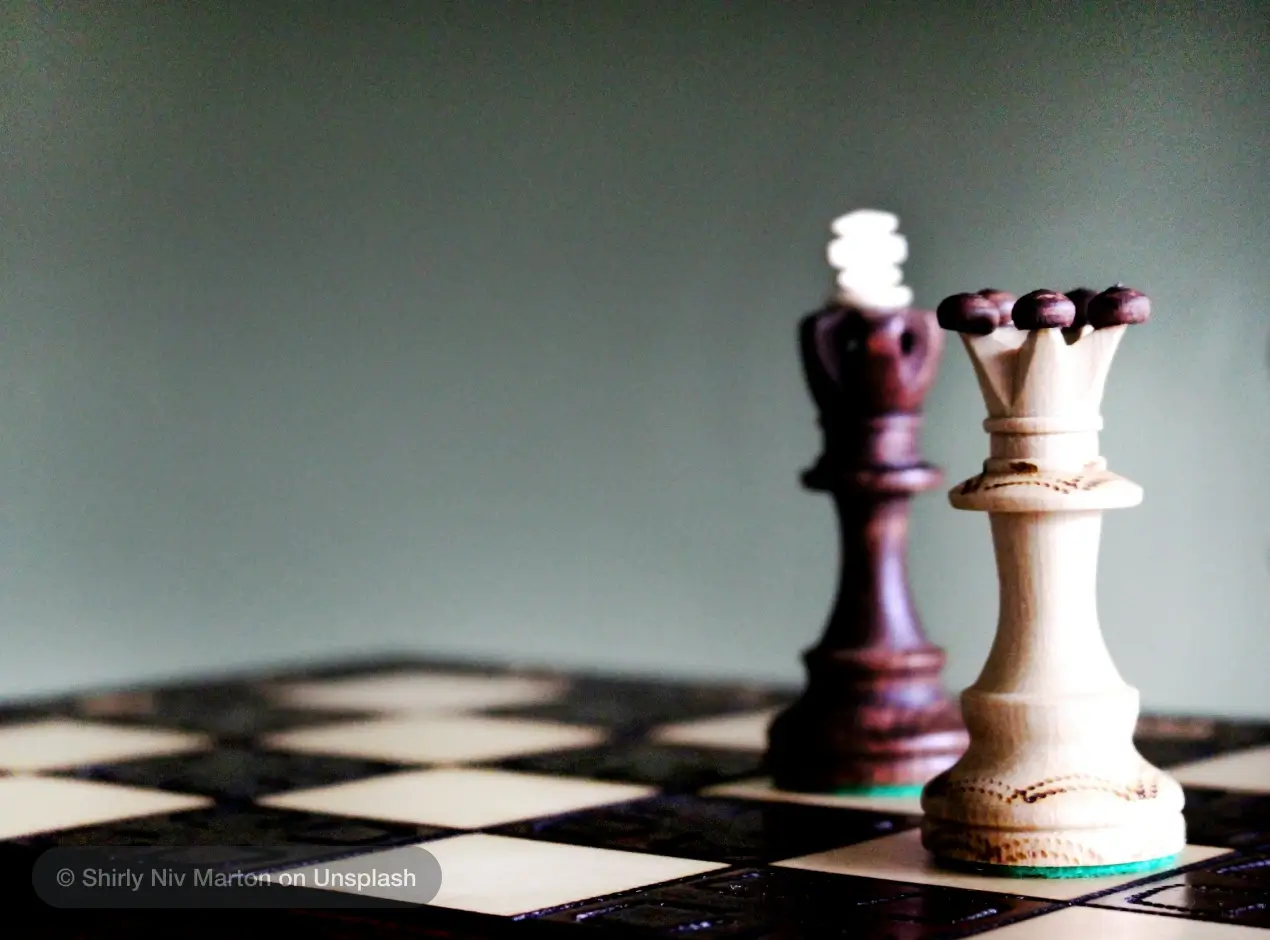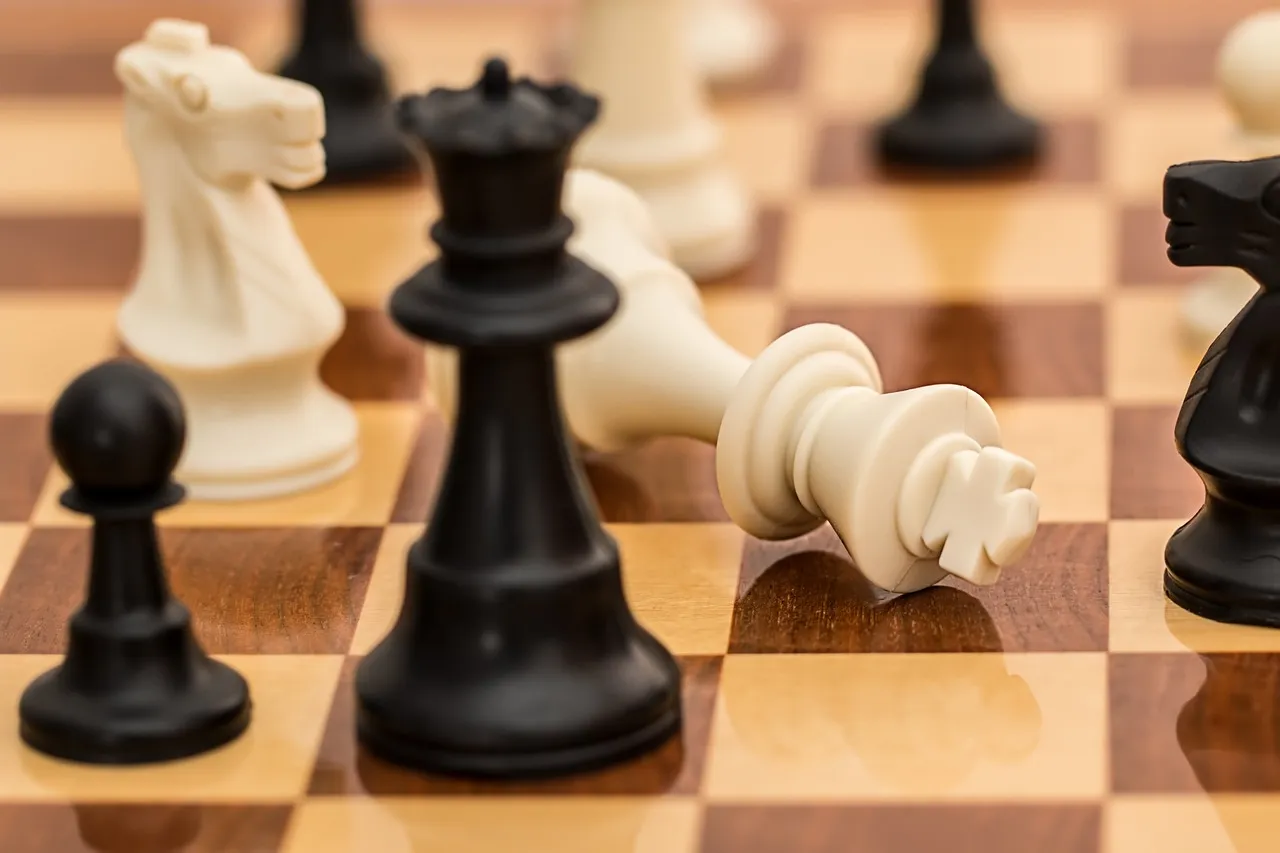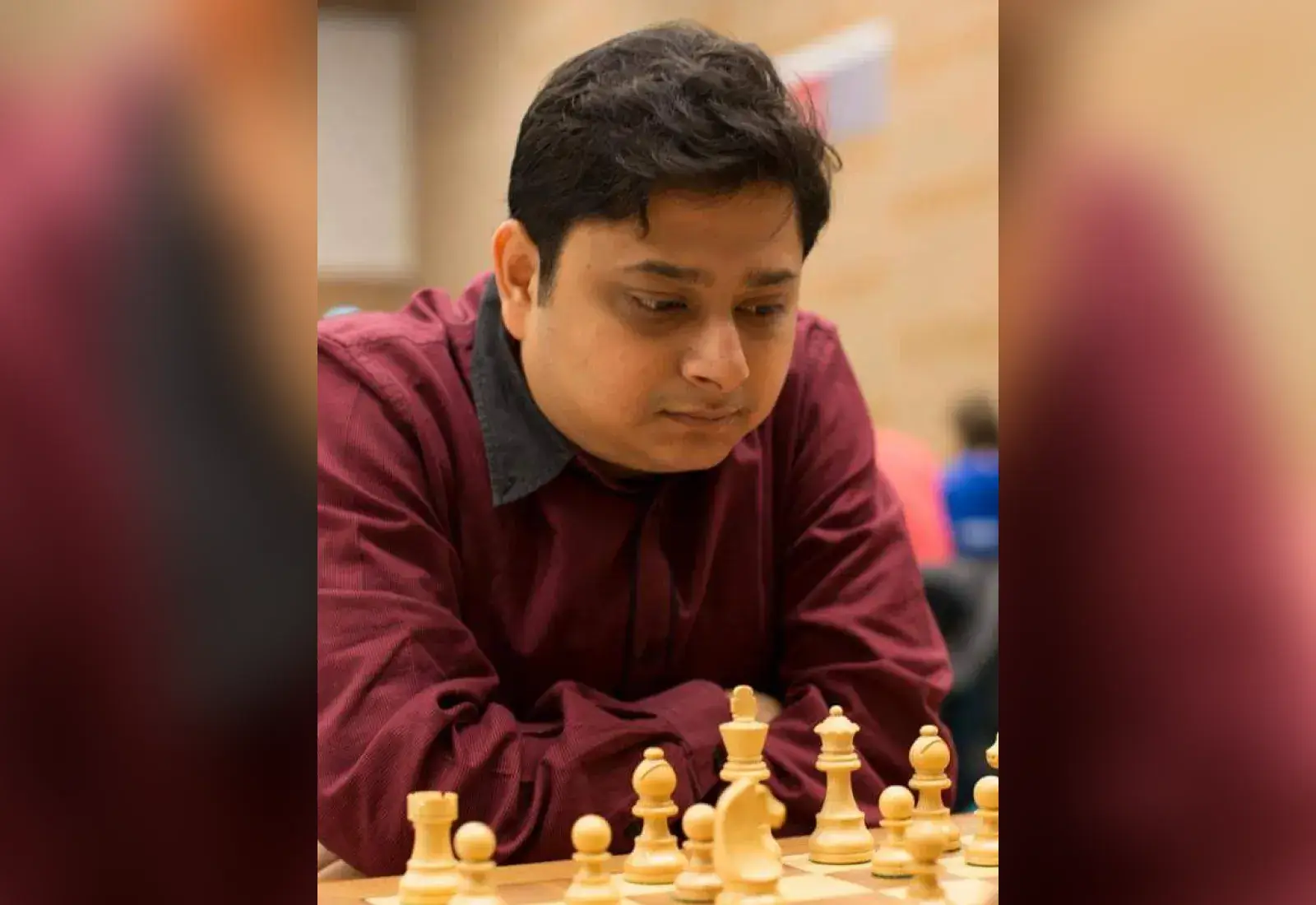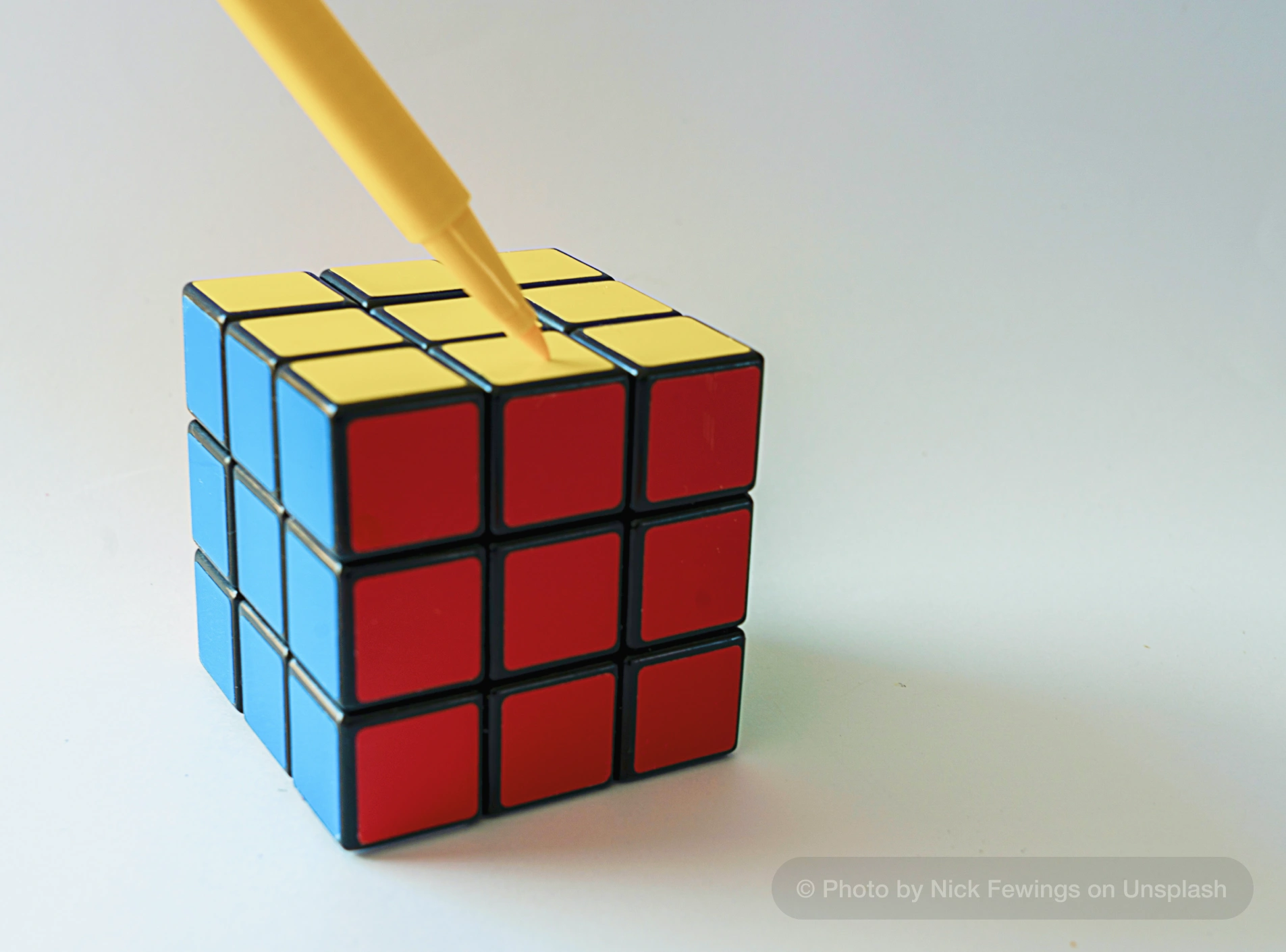Overview
Chess is a strategic board game. It has been played for centuries and is known for its deep complexity and intellectual challenge. It originated in India around the 6th century AD. Later, the game spread to Persia, and then to the Islamic world. Eventually, the game spread to Europe, where it evolved into its modern form. The chessboard consists of 64 squares arranged in an 8x8 grid.
At the beginning of the game, the players start with 16 pieces spread out on either side of the chess board. Each player has - one king, one queen, two rooks, two knights, two bishops, and eight pawns. The aim is to checkmate the opponent's king. The player has to capture the king in a position (in check) where there is no legal move to escape the threat of capture.
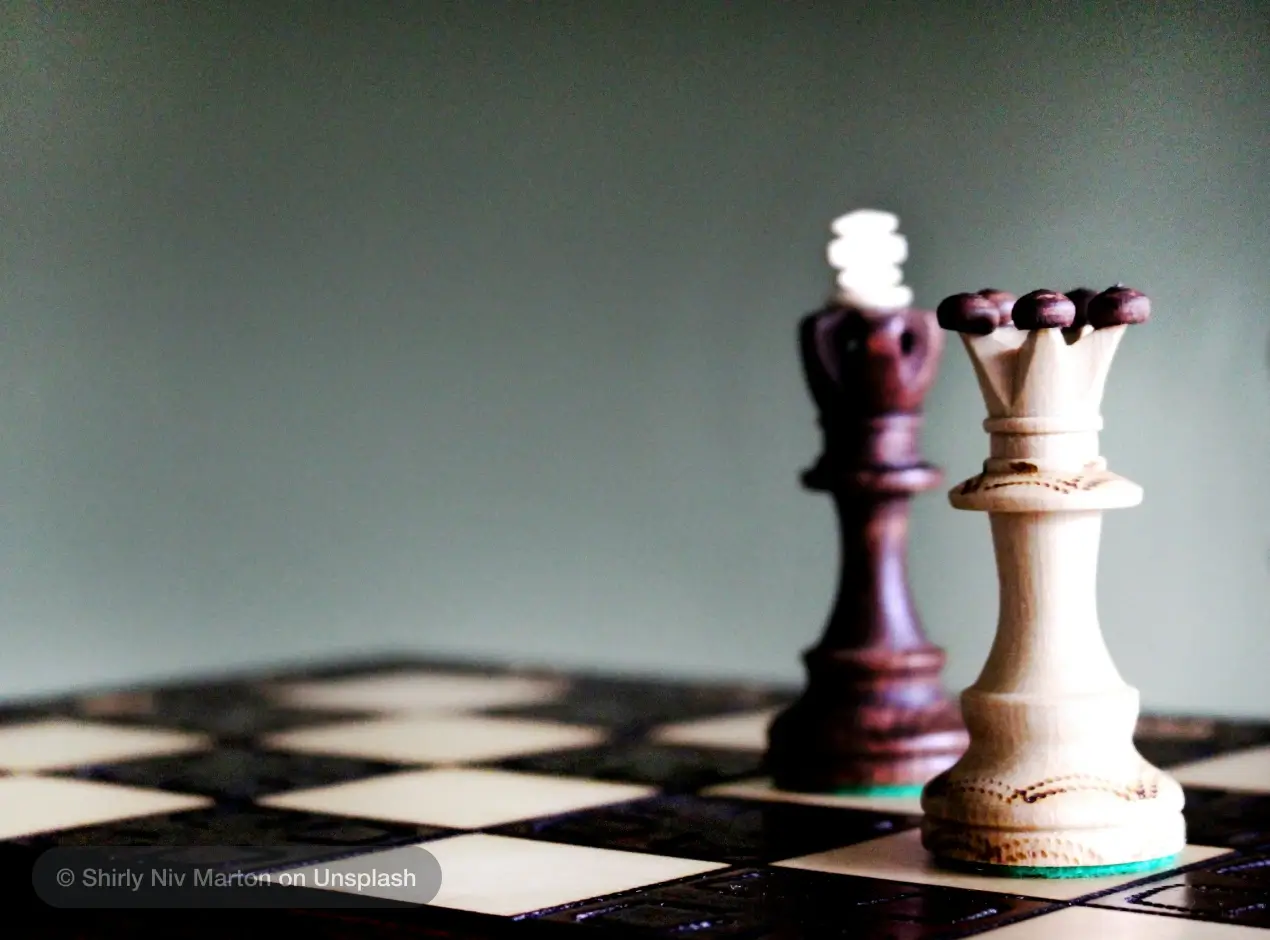
The game begins with the pieces set in a standard arrangement, with each type of piece moving in a distinct way. Pawns move forward one square but capture diagonally. Knights move in an L-shape. Bishops move diagonally. Rooks move horizontally or vertically. The queen can move any number of squares in any direction. And the king moves one square in any direction.
The game involves continued offense and defense till any of the players checkmates the oponent. This requires the players to plan the moves ahead of time. They anticipate their opponent's strategy and adapt to changing situations on the board.
Chess is divided into three phases: the opening, the middlegame, and the endgame. The opening focuses on piece development and control of the center of the board. The middle game involves maneuvering for position, launching attacks, and defending key squares and pieces. In the endgame when few pieces remain, the focus shifts to promoting pawns and achieving checkmate. Each phase requires different skills and strategic thinking.
The game's popularity has led to the establishment of international competitions. World Chess Championship is at the pinnacle of competitive play. Chess has included in acdemic curriculum for its cognitive benefits. It enhances problem-solving skills, memory, and concentration. Moreover, the rise of computer chess programs and online platforms has made the game more accessible. It allows players of all levels to learn, compete and improve. Chess continues to be a global pastime. It is celebrated for its depth, beauty, and the intellectual rigor it demands.
History of Chess
The history of chess is a rich and intricate tale that spans centuries and cultures, beginning in ancient India around the 6th century AD. The game, originally known as "chaturanga," was a simulation of Indian warfare.
The term "Chaturanga" comes from Sanskrit, an ancient language of India. It means "four divisions" or "four parts." This refers to the four parts of an army in ancient Indian warfare: infantry, cavalry, elephants, and chariots. These divisions are represented in the game by the pawns, knights, bishops (elephants), and rooks (chariots). Chaturanga was designed to simulate a battle, with these different types of military units moving and fighting on the board.
Rules of Chaturanga
It featured four divisions of the military represented by the pieces. The pawns represented the infantry. Likewise, knights, bishops, and chariots represented cavalry, elephants, and chariots respectively.
The king moved one square in any direction, like in modern chess. The chariot moved like the rook, in straight lines along rows and columns. The elephant moved diagonally, but only two squares at a time, and could jump over pieces. The horse moved in an L-shape, like the knight in modern chess. The boat moved one square diagonally. Pawns moved one square forward and captured diagonally.
The goal was to capture the opponent's king, which evolved into the concept of checkmate. The rules of Chaturanga were more complex and varied in different regions. Over time, as the game spread to Persia and other places, the rules were simplified.
From Chaturanga to Shatranj
Chaturanga spread to Persia through trade and conquest. The Persians called it Shatranj. The rules of Shatranj were a bit different from Chaturanga. The pieces and the board were mostly the same. However, the moves changed slightly. For example, the elephant became the bishop. The boat became the queen- - advisor to the king. The movement of the other pieces was adjusted to make the game faster and easier to understand
In Shatranj, players aimed to checkmate the king, just like in modern chess. The Persians kept many original rules but made the game easier to understand and play. This helped the game become popular in many countries.
As the Islamic conquests expanded, chess spread throughout the Muslim world. Islamic scholars further refined the game. Chess became a part of literature, art, and philosophy. And it was played widely among both the elite and common people. The Islamic world's love for chess facilitated its spread into Europe. It spread through Spain and Italy during the Middle Ages.
15th Century Europe
The 15th century was a transformative period for chess in Europe. The rules of the game went through significant changes that laid the foundation for modern chess. Noteworthy contributors were Spain, Portugal, Italy, Germany, and France.
Key Developments
Changes in Piece Movement:
Queen: The most significant change was the enhancement of the queen's power. Initially moving only one square diagonally, the queen's range was expanded to move any number of squares along ranks, files, and diagonals, making it the most powerful piece on the board.
Bishop: The bishop, which previously moved only two squares diagonally and could jump over pieces, was given the ability to move any number of squares diagonally, greatly increasing its influence on the game.
Pawn: The introduction of the two-square initial move for pawns allowed for more dynamic and faster openings. This also led to the development of en passant, a rule that allowed pawns to capture enemy pawns that bypassed their attack path using the two-square move.
Standardization of Rules:
The rules became more standardized across Europe, facilitating international play and competition.
Castling, a special move involving the king and rook, was formalized, though the specific mechanics varied regionally before becoming uniform later.
Checkmate and Stalemate:
The concepts of checkmate (threatening the king with capture and giving the opponent no legal moves to escape) and stalemate (where a player has no legal moves and is not in check) became more refined.
Major Contributors
Spain and Portugal:
Manuscripts like the "Repetición de Amores y Arte de Ajedrez" by Luis Ramírez de Lucena were published in 1497 in Spain and Portugal. These provided detailed descriptions of the new rules and strategies, making it one of the earliest printed books on modern chess.
Italy:
Italy became a chess hub during the Renaissance, with players like Gioachino Greco, who was one of the first to record his games and write extensively about chess strategies.
Germany:
German players and authors also contributed to the development and dissemination of chess knowledge. Manuscripts and books from this region helped standardize and propagate the new rules.
France:
The French court played a significant role in popularizing chess. The game was a favorite pastime among the nobility, which helped establish its status as a prestigious and intellectual pursuit.
Cultural Impact
Art and Literature: Chess found its way into the art and literature of the time, symbolizing intellect, strategy, and nobility. Chess problems and compositions became popular, with patrons sponsoring competitions and exhibitions.
Social and Educational Tool: Chess was used as a tool for teaching strategy and critical thinking, reflecting broader intellectual trends of the Renaissance.
19th century
In the 19th century, chess became very popular in Europe and America. This period saw many important changes and developments in the game.
Chess clubs started to appear in many cities. People came together to play and learn chess. These clubs helped chess become a common pastime. Chess books and magazines were published, making it easier for people to learn the game and improve their skills.
The first official chess tournaments began in the mid-1800s. In 1851, the first international tournament was held in London. Players from different countries competed against each other. This tournament was won by Adolf Anderssen, a famous German player.
During this time, new chess strategies and tactics were developed. Players like Paul Morphy from America and Wilhelm Steinitz from Austria became very famous. Morphy was known for his brilliant and aggressive style. Steinitz introduced new ideas about controlling the center of the board and playing defensively.
Steinitz also became the first official World Chess Champion in 1886. He played against Johannes Zukertort in a match that was widely followed. Steinitz's win marked the start of the World Chess Championship, which continues to this day.
The 19th century also saw the creation of chess clocks. These clocks made sure that players didn't take too long to make their moves. This invention helped make tournaments more fair and organized.
20th Century
In the 20th century, chess continued to grow and change. It became even more popular around the world. Many important events and developments happened during this time.
In the early 1900s, new chess openings and strategies were studied. Players like José Capablanca from Cuba and Alexander Alekhine from Russia became famous. Capablanca was known for his smooth, effortless style. Alekhine was known for his aggressive and creative play. Both became World Chess Champions.
In 1948, the World Chess Federation (FIDE) started organizing the World Chess Championship. This made the competition more official and regular. FIDE also organized other tournaments and events, helping to spread chess globally.
During the mid-20th century, the Soviet Union became very strong in chess. Soviet players like Mikhail Botvinnik, Anatoly Karpov, and Garry Kasparov dominated the chess world. They used scientific methods to study the game and trained very hard. This made them very successful.
In 1972, a famous match took place between Bobby Fischer from the United States and Boris Spassky from the Soviet Union. Fischer won and became World Chess Champion. This match was very important because it happened during the Cold War. It made chess very popular in the United States and other countries.
In the 1980s and 1990s, Garry Kasparov became one of the greatest chess players ever. He held the World Chess Champion title for many years. Kasparov's matches against Anatoly Karpov were very exciting and closely followed by chess fans.
The 20th century also saw the rise of computers in chess. In 1997, a computer called Deep Blue defeated Garry Kasparov in a match. This was a historic moment, showing that computers could play chess at a very high level.
Present Scenario
Today, chess enjoys global popularity, with millions of players and a vibrant online community. International competitions, such as the World Chess Championship and the Chess Olympiad, continue to draw attention. Chess is not only a beloved pastime but also a subject of academic study, valued for its cognitive benefits and its rich history that reflects the cultural exchanges and intellectual developments of human civilization.
Chess Rules
FIDE, the International Chess Federation, publishes the rules of chess. These rules are in FIDE's Handbook. Different unaffiliated organizations and individual publishers may have slightly different rules. The latest revision of FIDE's rules was in 2023.
Also read - How To Play Chess: 4 Basic Rules Of Chess You Must Know
Setting up the Chess Board
Chess is played on the 8 by 8 board consisting of 64 boxes. Chess pieces are divided into two sets - dark and light, referred to as black and white. Each chess set has sixteen pieces. It includes one king, one queen, two rooks, two bishops, two knights, and eight pawns.
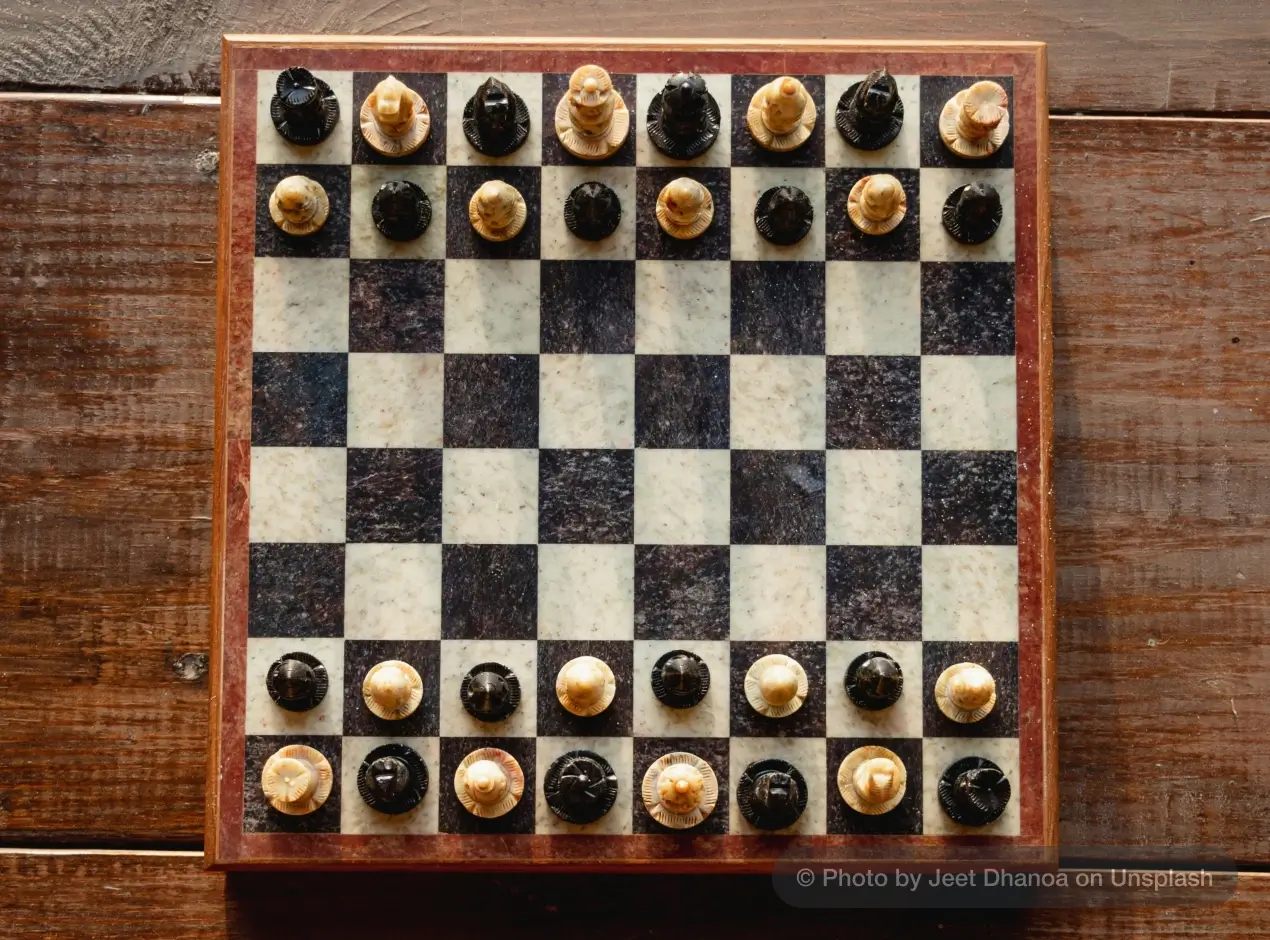
The chess pieces are set up in a specific manner at the beginning of the game. Learn how to set up the chess board in details.
And, as you do that, it is also important to learn about the chess pieces, their roles, and movements, read Beginners Chess Strategy - 7 Basics to Masterstroke.
Phases of Chess Game
There are three phases of the chess game, namely, opening, middle game, and end game.
Chess Opening
The opening phase in chess is all about setting up a solid structure, gaining control of key squares, and preparing for future attacks. It involves careful piece development, central control, and early king safety. Strategic planning at this stage lays the groundwork for the middlegame and can greatly influence the outcome of the match.
To know the details, read - The Ultimate Guide to Chess Openings.
Chess Middle Game
In the middle game, the player should focus on controlling the center of the board. Keeping pieces in the center makes them stronger and more flexible. Planning attacks is important. The player should look for ways to threaten the opponent’s pieces and pawns. Creating threats forces the opponent to defend.
Defending is also crucial. The player must protect their pieces and avoid leaving them unguarded. It's important to watch for tactics like forks, pins, and skewers. These tactics can help gain an advantage.

The player should aim to create good positions for their pieces. Moving pieces to stronger squares can increase their power. It is important to coordinate the pieces, making them work together.
The player should also try to weaken the opponent’s position. Attacking weak pawns or unprotected pieces can create opportunities. Always be mindful of the opponent’s plans and be ready to counter them.
Chess End Game
In the end game, the player should use their king as an active piece. Moving the king to the center can help control the board. The player should also try to promote their pawns. Moving pawns to the other side of the board allows them to become queens or other powerful pieces.
The player must be careful to avoid stalemate. Stalemate happens when the opponent has no legal moves but is not in check. This results in a draw. The player should aim for checkmate instead. Checkmate means trapping the opponent's king so it cannot move and is in check.
It is important to simplify the position. Capturing the opponent's pieces can make it easier to win. The player should look for ways to create passed pawns. A passed pawn has no opposing pawns blocking its way to promotion.
End game strategy also includes controlling key squares. Placing pieces on these squares can limit the opponent’s options. The player should always be aware of both their own and the opponent's remaining pieces and pawns.
Checkmate
Checkmate is the goal of chess. It happens when the opponent's king is in check and cannot escape. To achieve checkmate, the player must trap the opponent's king. The king cannot move to any safe square.
To set up a checkmate, the player often uses two or more pieces. For example, a queen and a rook can work together to trap the king. The player should control the squares around the king. This limits where the king can move.
The player should look for patterns to help checkmate. Common patterns include the back rank checkmate and the ladder checkmate. In a back-rank checkmate, the king is trapped in the back row by a rook or queen. In a ladder checkmate, two rooks or a rook and queen trap the king by moving in a ladder-like pattern.
It is important to be patient and careful. The player should make sure each move puts the king in a more trapped position. If the opponent can block or capture the attacking piece, it is not a checkmate.
In the end game, the player should use their king to help. The king can support other pieces in trapping the opponent's king.
Checkmate means the game is over, and the player wins. Practicing checkmate patterns can help the player become better at finishing the game.
Win or Draw
A chess game can end in a win or a draw.
Win
- Checkmate: The opponent's king is in check and cannot escape.
- Resignation: A player gives up, conceding the game. If the opponent cannot checkmate, it's a draw.
- Win on Time: In timed games, a player wins if the opponent runs out of time, as long as checkmate is possible.
- Forfeit: A player loses by cheating, breaking rules, or misconduct.
Draw
- Stalemate: The player to move has no legal moves and is not in check.
- Dead Position: Checkmate is impossible for both players.
- Draw by Agreement: Both players agree to a draw.
- Threefold Repetition: The same position occurs three times.
- Fifty-Move Rule: No pawn moves or captures in the last fifty moves.
- Draw on Time: The game is a draw if a player runs out of time and the opponent cannot checkmate.
- Draw by Resignation: If a player resigns and the opponent cannot checkmate, the game is a draw.
Famous Chess Grandmasters
Here are some famous Chess grandmasters in the world:
♦ Magnus Carlsen: Current World Chess Champion known for his deep positional understanding and endgame mastery.
♦ Fabiano Caruana: One of the strongest challengers to Carlsen, known for his solid and tactical play.
♦ Ding Liren: Leading Chinese Grandmaster known for his strategic depth and resilience in tough positions.
♦ Ian Nepomniachtchi: Russian Grandmaster with a sharp and aggressive style, known for his strong opening preparation.
♦ Levon Aronian: Armenian Grandmaster admired for his creative play and ability to handle complex positions.
♦ Harshal Save: A seasoned chess player and coach who has trained over 1200 students across all age groups.
♦ Viswanathan Anand: A former World Chess Champion and one of the greatest chess players in history, known for his versatility, creativity, and deep understanding of the game.
♦ Abhishek Giri: A World Fide Rated Chess Champion and Coach who teaches students from over 130 countries.
♦ Saptarshi Roy Chowdhury: The winner of the title - 51st Grandmaster of India. Saptarshi has played with and checkmated some of the World Champions.
♦ Pentala Harikrishna: A top Indian Grandmaster known for his strong positional play and consistency in international tournaments

